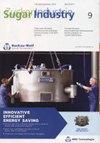Significant energy savings in the beet sugar industry to reach the decarbonization goals
IF 0.2
4区 农林科学
Q4 FOOD SCIENCE & TECHNOLOGY
引用次数: 0
Abstract
Biomass-based energy (solid fuel or biogas) and green electricity take a growing share in today’s low-carbon/carbon-free energy sources. Contrary to industries with high-temperature energy consumption (e.g. steel or cement industries), the sugar industry uses relatively low-temperature energy (except for milk of lime production). To reach low-carbon/carbon-free reduction, the sugar industry will have to re-design its complete energetic scheme. The panorama of solutions answering the aforementioned questions are reviewed. Among these solutions, the optimization of the process by using existing well-known technologies is the 1st option: mechanical vapour re-compressors (MVR), heat pump, cogeneration technologies, by-product anaerobic digestion, etc. Combining these solutions will support the sugar industry to decrease significantly its specific energy consumption. As a reference, today’s sugar factories have a specific consumption between 900 to 1200 kWh of primary energy per tonne of sugar. A target for the future is to decrease the specific primary energy consumption to 620 kWh per tonne of sugar (without pulp drying). This new benchmark could be even improved in the case of using low-carbon electricity imported from the grid. How far could one go into the decarbonization of beets sugar factories? Is the objective of having net-zero emissions for sugar production realistic?显著节约能源,达到甜菜制糖行业脱碳目标
生物质能(固体燃料或沼气)和绿色电力在当今低碳/无碳能源中所占的份额越来越大。与使用高温能源的工业(如钢铁或水泥工业)相反,制糖工业使用相对低温的能源(除了生产牛奶和石灰)。为了达到低碳/无碳减排,制糖业将不得不重新设计其完整的能源方案。回顾了回答上述问题的解决方案的全景。在这些解决方案中,利用现有的知名技术优化工艺是第一个选择:机械蒸汽再压缩机(MVR)、热泵、热电联产技术、副产品厌氧消化等。这些解决方案的结合将支持制糖行业显著降低其比能耗。作为参考,今天的糖厂每吨糖的一次能源消耗在900到1200千瓦时之间。未来的目标是将特定的一次能源消耗减少到每吨糖620千瓦时(不含纸浆干燥)。在使用从电网进口的低碳电力的情况下,这个新的基准甚至可以得到改善。甜菜糖厂的脱碳能走多远?实现糖生产净零排放的目标现实吗?
本文章由计算机程序翻译,如有差异,请以英文原文为准。
求助全文
约1分钟内获得全文
求助全文
来源期刊

Sugar Industry-Zuckerindustrie
工程技术-食品科技
CiteScore
0.50
自引率
50.00%
发文量
22
审稿时长
18-36 weeks
期刊介绍:
Sugar Industry / Zuckerindustrie accepts original papers (research reports), review articles, and short communications on all the aspects implied by the journals title and subtitle.
 求助内容:
求助内容: 应助结果提醒方式:
应助结果提醒方式:


